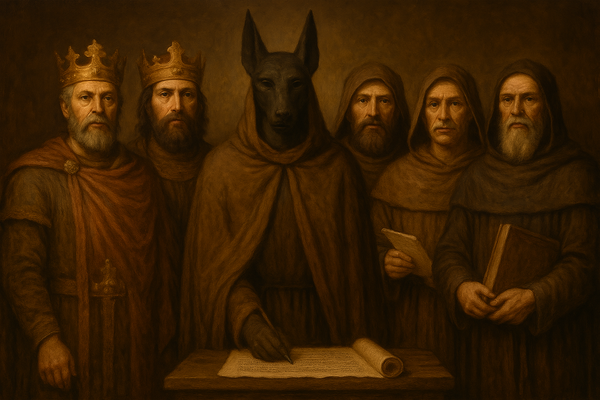Giant War

Genesis 14: A War Between Giants and Men
What if Goliath was the weakest of his kind and the remnant of his people? Goliath wasn't the first giant who waged war against the Israelites. He was the last. The first war we see between giants and men was long before Israel ever existed; a story found in Genesis 14.
Genesis 14 is one of the most intriguing of the often-overlooked stories in the Bible. It begins with a description of the four kings who led the attack on the five cities of the plain: Chedorlaomer, king of Elam; Tidal, king of Goiim; Amraphel, king of Shinar; and Arioch, king of Ellasar. These kings were all-powerful rulers, and their armies were vast.
The five cities of the plain were located in the Jordan Valley, and they were known for their wealth and prosperity. They had become very powerful and decided to rebel against Chedorlaomer and challenge his authority. Chedorlaomer and the other who still sided with him attacked the cities, motivated by greed and pride.
The five cities of the plain were most likely able to put up a fierce resistance, but they were eventually defeated. The kings who attacked them took their spoils of war and returned home.
One of the most overlooked aspects of this story is the fact that it mentions tribes of giants. The text says that the kings of the five cities of the plain were "Rephaim" a race of giants who were known for their great size and strength.

The Rephaim were not the only giants mentioned in the Bible. Other passages refer to the Anakim, the Emim, and the Zamzummin as being giants. In fact, there were many giant tribes.

The verse that points out Rephaim and other associated tribes of giants in the story is Genesis 14:5.
Genesis 14:5
In the fourteenth year Chedorlaomer and the kings who were with him came and defeated the Rephaim in Ashteroth-karnaim, the Zuzim in Ham, the Emim in Shaveh-kiriathaim,
These terms would have stood out to the eyes of an ancient Jewish reader. It was understood that these people groups contained giants who were descendants of the Nephilim.
Deuteronomy 2:10-11
The Emim lived there before them; a people great and numerous, and tall as the Anakim. Like the Anakim, they too were considered giants, but the Moabites called them Emim.
Deuteronomy 2:20-21
(It is also counted as a land of Rephaim. Rephaim formerly lived there—but the Ammonites call them Zamzummim— a people great and many, and tall as the Anakim; but the LORD destroyed them before the Ammonites, and they dispossessed them and settled in their place,
Deuteronomy 2 mentions the Rephaim, Emim, and Zuzim (also called the Zamzummim) and relates them all to the Anakim (the sons of Anak) who we know because of Numbers 13:33 are descendants of the Nephilim.
Numbers 13:33
And there we saw the Nephilim (the sons of Anak, who come from the Nephilim), and we seemed to ourselves like grasshoppers, and so we seemed to them.”
It's because of these passages that we know that the 5 kings that were defeated were giants. We also have the commentary of the Jewish historian Flavius Josephus. He recounts the story like so:
Antiquities of the Jews - Book 1 Chapter 9
AT this time, when the Assyrians had the dominion over Asia, the people of Sodom were in a flourishing condition, both as to riches and the number of their youth. There were five kings that managed the affairs of this county: Ballas, Barsas, Senabar, and Sumobor, with the king of Bela; and each king led on his own troops: and the Assyrians made war upon them; and, dividing their army into four parts, fought against them. Now every part of the army had its own commander; and when the battle was joined, the Assyrians were conquerors, and imposed a tribute on the kings of the Sodomites, who submitted to this slavery twelve years; and so long they continued to pay their tribute: but on the thirteenth year they rebelled, and then the army of the Assyrians came upon them, under their commanders Amraphel, Arioch, Chodorlaomer, and Tidal. These kings had laid waste all Syria, and overthrown the offspring of the giants. And when they were come over against Sodom, they pitched their camp at the vale called the Slime Pits, for at that time there were pits in that place; but now, upon the destruction of the city of Sodom, that vale became the Lake Asphaltites, as it is called. However, concerning this lake we shall speak more presently. Now when the Sodomites joined battle with the Assyrians, and the fight was very obstinate, many of them were killed, and the rest were carried captive; among which captives was Lot, who had come to assist the Sodomites.
Josephus clarifies that the Rephaim were giants, removing all doubt from the reader's mind.
The story of Genesis 14 suggests that the Israelites were not the first people to fight against giants. The four kings who attacked might possibly have been giants as well, as some have argued, but because the Bible doesn't tell us they were (and no other texts or historians we know of do so either) we can't be completely sure. It does tell us that the 5 kings of the plain were, and it would be strange to only point out one side as being Rephaim if both of them were. Whether or not those 4 kings were, the armies were most likely human and this is therefore still an example of humanity actually overcoming giants using overwhelming force. The Israelites, on the other hand, were a smaller nation and relied on their God to defeat such terrible foes.
This story shows that the Israelites were not the only people who had to face the challenge of giants. Other peoples in the ancient world also had to deal with these fearsome creatures.
Then comes the twist
In this epic story of a greedy and power-hungry humanity against the dangerous giants and their armies, the narrative shifts focus:
Genesis 14:12
They also took Lot, the son of Abram's brother, who was dwelling in Sodom, and his possessions, and went their way.
We are told that Abram, the man whom God chose to start His chosen people group, has a nephew who was living under the rule of one of these giant kings in their land. Lot ends up in the middle of this war and gets taken along with all of his possessions. Abram finds out, gathers a small army, and then proceeds to defeat the very armies that defeated the giants.
After this astounding victory, the king of Sodom asks for his men back and offers Abram the wealth of the city (which is what the other kings sought). Abram, however, tells the king he already swore to God that he would never take that plunder and says only his three allies will receive their share.
Genesis 14:24
I will take nothing but what the young men have eaten, and the share of the men who went with me. Let Aner, Eshcol, and Mamre take their share.”
We were introduced to these three allies earlier in verse 13:
Genesis 14:13
Then one who had escaped came and told Abram the Hebrew, who was living by the oaks of Mamre the Amorite, brother of Eshcol and of Aner. These were allies of Abram.
These allies of his were three brothers, and it says that they were Amorites. This is a fairly shocking statement. The Amorites are well known in the Bible as often being enemies of God and his people and most notably being giants as well.
Deuteronomy 1:4
after he had defeated Sihon the king of the Amorites, who lived in Heshbon, and Og the king of Bashan, who lived in Ashtaroth and in Edrei.
Deuteronomy 3:11
(For only Og the king of Bashan was left of the remnant of the Rephaim. Behold, his bed was a bed of iron. Is it not in Rabbah of the Ammonites? Nine cubits was its length, and four cubits its breadth, according to the common cubit.)
King Sihon and Og are infamous amorite kings that Moses and his people faced when heading toward the promised land, and King Og is specifically mentioned as being a remnant of the Rephaim. God Himself boasts of defeating them when only He could.
Amos 2:9
“Yet it was I who destroyed the Amorite before them, whose height was like the height of the cedars and who was as strong as the oaks; I destroyed his fruit above and his roots beneath.
So, in an ironic twist, Abram fights alongside 3 giants and 300+ men to free his nephew from the humans who overthrew the nation previously ruled by giants. This is the only passage of the Bible that mentions giants fighting alongside God's people.
Genesis 14 is one of many examples where a passage that may seem dull and boring at first glance is an exciting tale when investigated. It is also a good example of how many people can read even the whole Bible and never notice just how often the giants and their tribes are mentioned. It is much easier to read on when you encounter something strange, and even easier when you think you understand, but Genesis 14 is a reminder that we must always dig deeper if we want to see the full picture. Genesis 6:4 wasn't lying when it said "There were giants in those days, and also afterward".
If you want to read more details about this war, I recommend reading chapter 15 of Ryan Pitterson's "Judgement of the Nephilim".




